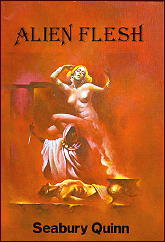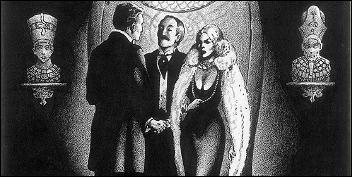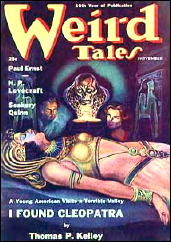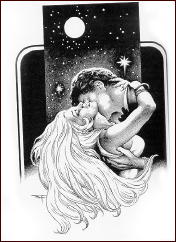Mon 14 Mar 2011
A Review by David L. Vineyard: SEABURY QUINN – Alien Flesh.
Posted by Steve under Pulp Fiction , Reviews , Science Fiction & Fantasy[9] Comments
SEABURY QUINN – Alien Flesh. Oswald Train; hardcover, 1977. Introduction by E. Hoffman Price; illustrations by Stephen Fabian. Expanded from the short story “Lynne Foster Is Dead!”, Weird Tales, November 1938.

There is a type of book that can only be called a peculiar classic; not a work of great literature, and yet both memorable and remarkable. Inevitably such books are faintly redolent of the decadent, faintly touched with the strange; Huysman’s La Bas and Against the Grain are such books, so were the works of E. H. Visiak and William Beckford, so Mari Corelli’s The Sorrows of Satan, and James Branch Cabell’s Jurgen. Everything William Morris wrote falls under this umbrella and most of Lord Dunsany.
And so does Seabury Quinn’s Alien Flesh.
Seabury Quinn reigned supreme in the old pulp Weird Tales. The popularity of his tales of psychic sleuth Jules de Grandin and his Watson, Dr. Trowbridge, far surpassed the popularity of H. P. Lovecraft, Robert E. Howard, Robert Bloch or any of the other legendary names associated with the magazine. He even produced one genuine classic, the haunting Christmas story Roads (the legendary Arkham House edition illustrated by science fiction master Virgil Finlay is one of the most attractive books ever printed by a small press)..
Alien Flesh is a novel, written after Weird Tales glory days, in 1950 not long before the series of strokes that ended Quinn’s fiction writing career. He lived until 1969, but no longer churned out tales of vampires, werewolves, cults, and covens, and only one book like Alien Flesh. Not that there could be more than one book like Alien Flesh.
She came slowly toward them passed the rows of glassed-in mummy cases. She was not tall, but very slim, with the force maigruer of youth, and wore a daringly low-cut evening gown of midnight blue and a blonde knee length mink coat draped crosswise across her shoulders. Her eyes were amber and her honey colored hair was drawn back from a pronounced widow’s peak to be looped in a loose figure eight at the nape of her neck … she was like Clytie in a velvet gown, Titania in pearls and mink. If she had suddenly unfolded moth- wings and taken flight Arundel would not have been too much surprised.

Hugh Arundel, Egyptologist, attending a new Egyptian exhibit at a New York museum is introduced to the fabulous Madame Foulik Bey, Ismet.
And something draws Arundel to her, something in her strange manner, and stranger eyes, something he can’t quite put a finger on.
In short order his life revolves around her. She becomes the axis all aspect of his thoughts turn on. And at every turn a new mystery, her nature possessing, “as many facets as a diamond.”
And yet despite her obvious feeling for him she holds him at bay.
Finally he pushes her and she relents and tells him her story,
Lynne Foster was a boyhood friend. They had gone to school together, dated together, both been fascinated with Egypt. Lynne Foster had disappeared in Cairo, possibly murdered.
“Here is the ending!” she knotted her small hands into fists and struck herself on the breast. Her head was thrown back, and her eyes were flushed with tears. “I am — or was — I don’t know which — Lynne Foster.”

And then she relates her — Lynne Foster’s — tale.
I did warn you this was a peculiar classic.
Lynne Foster in Egypt fell afoul of ancient sorcery, and in his western arrogance was punished. He was transformed, from the strong and tough minded young man to …
Besides me there was no one else in the room!
As you might imagine this could go wrong very quickly, and it is a testament to the old pulp master’s skills that it does not. He finds a fine balance between horror, humor, whimsy, unabashed Arabian nights, the erotic — suggested but never spelled out — and sensuality — the book drips with that — as he spins out the tale of the fortunes of Lynne Foster, now Ismet a simple harem girl.

Again, I said this was a peculiar book and it is difficult to convey to any reader how well Quinn handles this difficult theme without slipping into either soft porn or outright comedy. The book recounts Ismet’s adventures, her first touches of romance in her new body, her battle with the mind of Lynne Foster and the emotions of the woman Ismet, and her rise to riches and power using Lynne Foster’s masculine mind and Ismet Foulik’s feminine charms.
I’m not sure I buy the sweepingly romantic ending, but Quinn more than prepares you for it, and after all, Hollywood used to churn out this kind of fantasy with regularity — though usually in the form of Thorne Smith comedy such as Turnabout or I Married A Witch.
Here it is deadly serious, but handled so deftly that the giggles that could easily turn to guffaws and destroy the entire mood are held at bay (at least while you are caught in Quinn’s spell, I can’t answer for later) and the reader manages to stay with Quinn thanks to his sheer story telling skills.
Once he gets you on his side he keeps you there, and plays deftly with both the reader’s willingness to suspend disbelief and also the key to any storyteller’s success, the readers desire to see what happens next. Quinn knew how to spin a tale and keep the pages turning, and here those skills serve him well. This isn’t the sort of book that can survive much in the way of the reader stopping to meditate on the story.

When this was reissued in 1977 by Oswald Train it came with an appreciative forward by Quinn’s friend and former pulp master E. Hoffman Price, a beautiful color cover by illustrator Stephen Fabian, and a full accompaniment of full page black and white illustrations also by Fabian. It’s a lovely little book and a perfect tribute to this most peculiar of peculiar classics.
I know many of you reading this description of the book, are going to say there is no way it could work in the form Quinn gives it, and no doubt it would not for many readers, but Alien Flesh, given half of a chance earns it’s place on that shelf of peculiar classics, and earns Quinn this much from me — I can’t think of another writer who could have pulled it off with half the charm, skill, and old fashioned pulp romanticizing.
If nothing else you turn each page just to see if he avoids the obvious traps — which he always does — and you reach the end glad to give him his choice of endings thankful for the memorable trip.
And one more peculiar classic finds its way onto the shelves.
March 15th, 2011 at 8:32 am
Another one for the “To Read” pile.
March 15th, 2011 at 9:19 am
Me too, Tim. I bought this book when it first came out, primarily tempted by of the cover and interior illustrations by Stephen Fabian, one of my all time favorite SF and Fantasy artists. Seabury Quinn was a name I only marginally recognized at the time, and I had no idea what the book was about until now. The book is supposed to be on the shelf in my study closet. I hope it’s still there!
March 15th, 2011 at 12:53 pm
Many, many years ago I was searching the shelves in the basement of the Strand Book Store on 12th St. in Manhattan when I stumbled ubto this book. When I first pulled itout I thought it might be a collection of short stories but the premise intrigued me and I bought it. I wasn’t completely satisfied with the ending and, having never been in a harem, I’m not sure how accurate the details are about harem life but this certainly was an unforgettable read.
March 15th, 2011 at 1:46 pm
I first read Seabury Quinn with a story in a 1940s anthology edited by Philip Stong. But he didn’t really make an impression on me until I discovered the Robert W. Lowndes edited “Magazine of Horror” and “Startling Mystery Stories” on the news stand. I remember how excited I was to find them in Fayetteville, NC after I was drafted and sent to Ft. Bragg. After that, every time I found one of the four Lowndes mags on the rack, it cheered me up during a generally gloomy period. Not bad for an investment of 50 cents.
Later I read one of Hoffman Price’s memoirs and he told of visiting Quinn and his wife in their Washington, DC apartment and how pleased he was to be reprinted even at the fraction of a cent a word.
I soon bought the Arkham House collection of de Grandin and Trowbridge stories. They were more fun reading in the little Health Knowledge mags. I also picked up the Mirage collection IS THE DEVIL A GENTLEMAN? in 1970 and enjoyed those non-series stories.
Quinn is so old-fashioned, he creaks but I am something of a sucker for that sort of thing. Not sure why I never ordered this novel but I probably will if I see one at a decent price.
March 15th, 2011 at 4:40 pm
Quinn wasn’t a great writer, but he does seem to have been a consistent and professional one. I’ve read a few of those collections that Popular put out in the 70’s. (I think it was Popular.) In certain amounts, his stories are pretty decent entertainment. Like Richard, I’m a sucker for that sort of thing.
Had no idea that Quinn wrote a novel with transgendered themes.
March 15th, 2011 at 5:32 pm
As far as I know Quinn only wrote three novels, a historical novel, THE DEVIL’S BRIDE the only de Grandin novel (yes, it was Popular Library with covers by famed sf artist Vincent Di Fate), and this.
I think THE PHANTOM FARM is the Arkham collection of his work, the title story adapted as an episode of Rod Serling’s NIGHT GALLERY with David McCallum.
I grant this one is grandly old fashioned, but whatever his faults Quinn was a gifted raconteur, a story teller of the first water, and this one holds together much better at novel length than it has any right to considering the subject.
An additional bonus of the Popular Library edition of the de Grandin stories is they all have informative introductions or afterwards by pulp collector and bookseller Robert Weinberg. In addition the complete Jules de Grandin is available in hardcover (or was) from the Battered Silicon Box.
Ray
As I said, I’m not sure I buy the ending either. Quinn makes it fit the book, but the minute he writes THE END your imagination can’t help thinking ‘well this is going to be a difficult marriage.’ But I guess that is our problem and not Quinn’s.
As far as accuracy goes, this is Arabian nights stuff, and probably has more to do with the classic Victorian porn LUSTS OF A TURKISH HAREM and E. M. Hull’s THE SHEIK than actual culture, history, or sociology.
I doubt it deeply bothered Quinn, so I say, why let it bother me? And really, it is no farther off the real world than the majority of popular fiction be it westerns or mysteries.
Despite the experience in North Africa during the war, when this was written the Middle East was still mostly Ali Baba, Sindbad, and Scheherazade to most Americans, and CASABLANCA about as close to realism as it got.
Quinn was to WEIRD TALES what Daly or Gardner were to BLACK MASK (well, much better than Daly, but the point is valid). While we remember and revere Lovecraft and Howard, month after month is was the name of Quinn on the cover and the presence of de Grandin that sold magazines. He’s not a great stylist, innovator, or creator of characters (those Irish cops get a little thick and de Grandin seems to speak Hercule Poirot instead of English or French), but he was a gifted storyteller with a fine grasp of the weird and offbeat.
This one is notable for how well it captures the late Victorian/Edwardian school of decadent writing, the ‘yellow’ era of works that dripped of incense, sputtering candles, draped velvet curtains, and sensuality. Of course he is closer to Rider Haggard and Sax Rohmer than Beardsley or Wilde, more Marie Corelli than Huysmans, but he at least lets some of that creep in. Considering the subject he couldn’t keep it out.
Once you pause to think about it this just can’t hold up. It’s all smoke and mirrors, but like a good magic trick it only has to amaze you while the illusionist is on stage performing, and while Quinn is on stage it does.
March 18th, 2011 at 3:48 pm
Hello,
I am enjoying this thread. However, Quinn only wrote 2 known novels. The Devil’s Bride, and Alien Flesh.
The Devil’s Bride was clapped together from a serial from Weird Tales.
The Phantom Fighter was the only collection of Jules de Grandin Stories published in his life time, and contained 10 stories, most of which appeared in the Popular Library reprints, overseen by Robert Weinberg.
Alien Flesh was an expanded version of another story entitled Lynn Foster is Dead, which was also originally published in Weird Tales.
Both the Bob lowndes Startling Mystery Stories, and the Magazine of Horror, etc.. and the Popular Library reprints were badly marketed and distributed. Vincent diFate is not a great supernatural artist, and who would look for Quinn in Science Fiction
Hope this helps.
CW.
March 19th, 2011 at 8:35 pm
Chris, I’m not surprised to learn that the Popular Library editions were badly distributed. You can find them online, but in the real world, they’ve managed to hide themselves really well.
At least I seldom run across them.
March 20th, 2011 at 3:46 pm
Hi, Dozy
You sometimes find them on eBay. However, for me they become too expensive, as most vendors are asking between $15 and $25 for one of them… add circa $15 shipping and handling, then I think they are not really worth it for me.
I start to quiver at the original Weird Tales at much more than that for late issues.
Chris.
Chris.